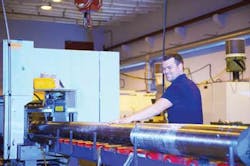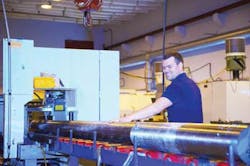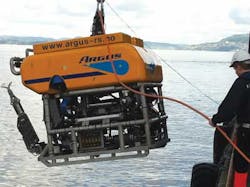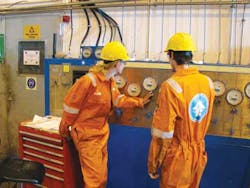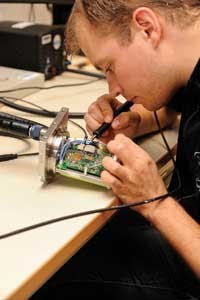Giant North Sea discoveries fuel optimism of Bergen's subsea cluster
John Bradbury
Special Correspondent
Members of Norway's NCE Subsea technology cluster in Bergen have good reason to be optimistic about the future of the offshore industry at the start of 2012.
Statoil recently announced that it plans to have subsea compression systems up and running by 2015 and a complete subsea "factory" by 2020. And global subsea and deepwater activity will reach new heights in the years to come, both in greenfield and brownfield activities, NCE's cluster members believe.
"There are more than 4,000 subsea wells worldwide right now," points out Trond Olsen, general manager of NCE Subsea based in Bergen. "Within five years you can expect that to almost double with new installations on the Norwegian and UK continental shelves, but also in Brazil, West and East Africa, and the Asia-Pacific and Australasia regions. The subsea market is expected to grow tremendously in 2012-2016 and beyond."
From Olsen's perspective, Bergen's specialized subsea cluster should benefit not just from the new installations, but also from the huge opportunity offered via "after market" services – supplying retrofit subsea hardware to enhance operational performance on existing fields.
Statoil/Lundin's Aldous/Avaldsnes discovery in the North Sea, which has been compared to the giant Troll field and which has estimated reserves in the region of 3 Bbboe, could become another major market opportunity for the cluster, Olsen believes. "Quite clearly there will be opportunities in the long run both in greenfield and in brownfield after market operations," Olsen observed. "And of course we cherish all new finds, especially a major find like Aldous/Avaldsnes in the North Sea."
Major members of the NCE Subsea cluster such as FMC Technologies, Aker Solutions, and Framo Engineering are highly likely to play a part in the development of Aldous/Avaldsnes. But Olsen says the discovery also sends a much bigger message to the global petroleum industry.
"What we are able to communicate to the rest of the world, and to potential future employees [in the industry], is that the North Sea era is not over," Olsen said. "As well as the importance of the find for the companies in the region, this positive news communicates the belief that there is probably more to come. If you look at the Troll field, there are around 100 subsea wells in service. Something of that scale is also possible at Aldous/Avaldsnes."
New data from the Statistics Norway, compiled on behalf of the Norwegian government, reinforces his belief in the future of the energy industry around Bergen. Its 2012 oil and gas industry forecast predicted a record expenditure of NOK 184.6 billion ($30.638 billion) on the Norwegian shelf. Olsen points out, however, that "the aftermarket part of the cluster did not see any downturn during the financial crisis of 2008/2009. In fact," he continued, "its activity increased in after market services." He noted that Aker Solutions has increased its number of its employees in that area; and that FMC plans to employ an additional 200 people this year within its after-market service business.
Underwater Technology Conference
Olsen's principle responsibilities include helping to form new links between companies within the subsea cluster in the Bergen region, and putting together Norway's Underwater Technology Conference (UTC), to be staged in Bergen in June. "The UTC is a core activity for us in the region. It is the oldest subsea technology conference in the world, started in 1980," he said. Olsen also noted UTC is expected to host speakers from operator, vendor, service, and supply companies throughout the world.
Future technology challenges will be one of the issues on the conference agenda. "We will also be looking at how to get access to qualified personnel resources for the industry," Olsen observed. "The bottleneck in the years to come for the industry will be recruiting and training enough qualified personnel."
Olsen also highlighted one particular session at UTC 2012 – a panel discussion entitled "Subsea growth – how to make it happen? Main supplier solutions." He noted that the conference organizers had gathered 10 representatives from different global suppliers to discuss nearby and future challenges.
Lighthouse project
Away from the conference stage, Olsen is working to build up various new technology initiatives that bring companies into closer collaboration. Various NCE member companies are collaborating on a "Lighthouse" project to investigate long-term environmental monitoring.
The project participants include UNI Research, Christian Michelsen Research, and the Norwegian Institute of Marine Research. They are seeking to develop methods for monitoring the total activities and stresses in the sea environment, that have been created by oil and gas production. "You need to have a better system than just measuring randomly to see if there are any effects," Olsen explains.
Although there is no demand at present from regulatory authorities for better environmental monitoring, Olsen says Statoil is keen on the subject and is driving research forward in this area. "I think it is business driven," he suggested.
Olsen also pointed to the need for "integrated environmental surveillance"; i.e., the ability to ensure that production is safe, free of any leakages and harm to the environment around any offshore installation and in the ocean in general. "We need to have a broader view on how to monitor and what to monitor to make sure production is safe at sea," he observed.
Environmentally sensitive areas offshore Norway, Brazil, Australia, and even offshore California could benefit from this type of technology, he claimed. "We need to come up with new measures and new methods of making absolutely sure that there are no harmful effects from oil and gas production," he said. "Then the industry can get access to new areas previously closed for exploration and production."
Recently, Statoil awarded a contract worth $24.88 million to a consortium comprising Kongsberg, IBM, and DNV to develop a real-time environmental monitoring system. Statoil's R&D center in Trondheim, Norway, placed the contract. It involves three years of work with a view to developing a pilot monitoring system ready for use on an operational asset.
Kongsberg Oil and Gas Technologies, and Kongsberg Maritime Subsea – which is providing sensors and communication technologies – will be involved in the work, while IBM will provide information integration and business analytical technology. DNV is to provide marine environmental analysis and advice on risk management practice.
Offshore Articles Archives
View Oil and Gas Articles on PennEnergy.com
